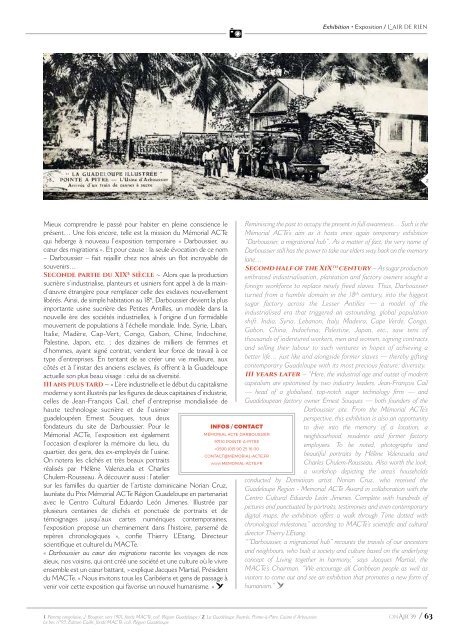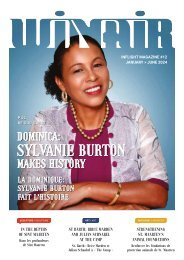ON AIR MAGAZINE #39
You also want an ePaper? Increase the reach of your titles
YUMPU automatically turns print PDFs into web optimized ePapers that Google loves.
Exhibition • Exposition / L’ air de rien<br />
2<br />
2<br />
Mieux comprendre le passé pour habiter en pleine conscience le<br />
présent… Une fois encore, telle est la mission du Mémorial ACTe<br />
qui héberge à nouveau l’exposition temporaire « Darboussier, au<br />
cœur des migrations ». Et pour cause : la seule évocation de ce nom<br />
– Darboussier – fait rejaillir chez nos aînés un flot incroyable de<br />
souvenirs…<br />
Seconde partie du XIX e siècle ~ Alors que la production<br />
sucrière s’industrialise, planteurs et usiniers font appel à de la maind’œuvre<br />
étrangère pour remplacer celle des esclaves nouvellement<br />
libérés. Ainsi, de simple habitation au 18 e , Darboussier devient la plus<br />
importante usine sucrière des Petites Antilles, un modèle dans la<br />
nouvelle ère des sociétés industrielles, à l’origine d’un formidable<br />
mouvement de populations à l’échelle mondiale. Inde, Syrie, Liban,<br />
Italie, Madère, Cap-Vert, Congo, Gabon, Chine, Indochine,<br />
Palestine, Japon, etc. ; des dizaines de milliers de femmes et<br />
d’hommes, ayant signé contrat, vendent leur force de travail à ce<br />
type d’entreprises. En tentant de se créer une vie meilleure, aux<br />
côtés et à l’instar des anciens esclaves, ils offrent à la Guadeloupe<br />
actuelle son plus beau visage : celui de sa diversité.<br />
111 ans plus tard ~ « L’ère industrielle et le début du capitalisme<br />
moderne y sont illustrés par les figures de deux capitaines d’industrie,<br />
celles de Jean-François Cail, chef d’entreprise mondialisée de<br />
haute technologie sucrière et de l’usinier<br />
guadeloupéen Ernest Souques, tous deux<br />
fondateurs du site de Darboussier. Pour le<br />
Mémorial ACTe, l’exposition est également<br />
l’occasion d’explorer la mémoire du lieu, du<br />
quartier, des gens, des ex-employés de l’usine.<br />
On notera les clichés et très beaux portraits<br />
réalisés par Hélène Valenzuela et Charles<br />
Chulem-Rousseau. À découvrir aussi : l’atelier<br />
sur les familles du quartier de l’artiste dominicaine Norian Cruz,<br />
lauréate du Prix Mémorial ACTe Région Guadeloupe en partenariat<br />
avec le Centro Cultural Eduardo León Jimenes. Illustrée par<br />
plusieurs centaines de clichés et ponctuée de portraits et de<br />
témoignages jusqu’aux cartes numériques contemporaines,<br />
l’exposition propose un cheminement dans l’histoire, parsemé de<br />
repères chronologiques », confie Thierry L’Etang, Directeur<br />
scientifique et culturel du MACTe.<br />
« Darboussier au cœur des migrations raconte les voyages de nos<br />
aïeux, nos voisins, qui ont créé une société et une culture où le vivre<br />
ensemble est un cœur battant, » explique Jacques Martial, Président<br />
du MACTe. « Nous invitons tous les Caribéens et gens de passage à<br />
venir voir cette exposition qui favorise un nouvel humanisme. »<br />
INFOS / C<strong>ON</strong>TACT<br />
MÉMORIAL ACTE DARBOUSSIER<br />
97110 POINTE-À-PITRE<br />
+0590 (0)5 90 25 16 00<br />
C<strong>ON</strong>TACT@MEMORIAL-ACTE.FR<br />
WWW.MEMORIAL-ACTE.FR<br />
Reminiscing the past to occupy the present in full awareness… Such is the<br />
Mémorial ACTe’s aim as it hosts once again temporary exhibition<br />
“Darboussier, a migrational hub”. As a matter of fact, the very name of<br />
Darboussier still has the power to take our elders way back on the memory<br />
lane…<br />
Second half of the XiX th century ~ As sugar production<br />
embraced industrialisation, plantation and factory owners sought a<br />
foreign workforce to replace newly freed slaves. Thus, Darboussier<br />
turned from a humble domain in the 18 th century, into the biggest<br />
sugar factory across the Lesser Antilles — a model of the<br />
industrialised era that triggered an astounding, global population<br />
shift. India, Syria, Lebanon, Italy, Madeira, Cape Verde, Congo,<br />
Gabon, China, Indochina, Palestine, Japan, etc., saw tens of<br />
thousands of indentured workers, men and women, signing contracts<br />
and selling their labour to such ventures in hopes of achieving a<br />
better life… just like and alongside former slaves — thereby gifting<br />
contemporary Guadeloupe with its most precious feature: diversity.<br />
111 years later ~ “Here, the industrial age and outset of modern<br />
capitalism are epitomised by two industry leaders, Jean-François Cail<br />
— head of a globalised, top-notch sugar technology firm — and<br />
Guadeloupean factory owner Ernest Souques — both founders of the<br />
Darboussier site. From the Mémorial ACTe’s<br />
perspective, this exhibition is also an opportunity<br />
to dive into the memory of a location, a<br />
neighbourhood, residents and former factory<br />
employees. To be noted, photographs and<br />
beautiful portraits by Hélène Valenzuela and<br />
Charles Chulem-Rousseau. Also worth the look:<br />
a workshop depicting the area’s households<br />
conducted by Dominican artist Norian Cruz, who received the<br />
Guadeloupe Region - Memorial ACTe Award in collaboration with the<br />
Centro Cultural Eduardo León Jimenes. Complete with hundreds of<br />
pictures and punctuated by portraits, testimonies and even contemporary<br />
digital maps, the exhibition offers a walk through Time dotted with<br />
chronological milestones,” according to MACTe’s scientific and cultural<br />
director Thierry L’Etang.<br />
““Darboussier, a migrational hub” recounts the travels of our ancestors<br />
and neighbours, who built a society and culture based on the underlying<br />
concept of Living together in harmony,” says Jacques Martial, the<br />
MACTe’s Chairman. “We encourage all Caribbean people as well as<br />
visitors to come out and see an exhibition that promotes a new form of<br />
humanism.”<br />
1. Femme congolaise, J. Bougrier, vers 1901, fonds MACTe, coll. Région Guadeloupe / 2. La Guadeloupe illustrée, Pointe-à-Pitre, L’usine d’Arboussier,<br />
Le ber, n°93, Edition Caillé, fonds MACTe, coll. Région Guadeloupe<br />
onAir 39 39<br />
63 63


















